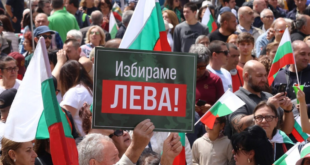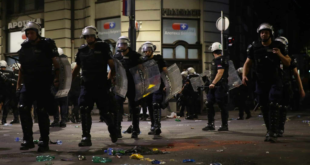Boris Tadic lost his presidential post in 2012 and has been demonized by his successors ever since – but despite growing irrelevancy, he’s still eyeing another starring role.
“We will see each other in some new movie,” Boris Tadic said in May 2012 after losing the presidential race to Tomislav Nikolic, one of the founders of today’s ruling Serbian Progressive Party, SNS.
After eight years as head of state and also head of the ruling Democratic Party, DS, Tadic’s failure to win another term initiated a dramatic political shift in Serbia, paving way for the ongoing dominance of the SNS, and its leader, current President Aleksandar Vucic.
The SNS’s “winner-takes-all” attitude, which has included demonizing the presidential loser, has successfully spread a narrative about Tadic’s “corrupt” and even “traitorous” rule ever since.
It has become a must for all politicians seeking to join ruling regime. The reign of the “yellow ones”, as the SNS rudely terms the DS – that being the party’s traditional colour – has become an excuse for everything bad happening in the country today.
This never-ending smear campaign is so effective also because it has some truth in it, especially for the working class in an impoverished country too weak to compete in the global economic race.
The more than decade-long rule of parties after the fall of Slobodan Milosevic’s regime in 2000, of which DS was the strongest most of the time, was marked by the rise of tycoons and the legitimization of their wealth created by dubious privatizations, which left thousands of people without jobs and former industrial centres without long-term economic perspectives.
The prosperity promised after the fall of Milosevic for most people never came, and the so-called “transition losers” turned to Vucic and Nikolic, who promised them a new beginning.
Paradoxically, Tadic has being accused of helping to create the SNS, which emerged out of the extreme nationalist Serbian Radical Party, led by a war criminal Vojislav Seselj.
The breakaway party’s leaders aimed to create a less extreme nationalist party that would not question Serbia’s EU ambitions.
In the view of many, Tadic helped create a political “monster” that went on to devour almost all the other parties in the country, especially its former rival, the DS, whose support is now negligible.
However, Tadic never really accepted being out of the spotlight. Soon after the election defeat in 2012, he restarted a political career by forming a small Social Democratic Party, SDS – with little success.
Although seen as a symbol of the demonized previous regime, Tadic, now 63, last week told NOVA.rs portal that he is willing to be the candidate of the united opposition in the 2022 presidential elections if no other suitable candidate emerges.
The idea was largely dismissed by other opposition leaders, but it said something about Tadic’s character and mindset.
Although a psychologist by profession, or perhaps because of that, he never really accepted his defeat or the strategic political mistakes he made in power. He lost the battle, but, in his mind, not the war.
Attempt to form ‘catch-all’ party fails
The son of a Communist-era dissident, Tadic entered politics in the mid-1990s campaigning against Serbia’s late strongman, Slobodan Milosevic.
Tadic served as Minister of Telecommunications and Defence in Serbia’s first post-Milosevic governments. He emerged as leader of the centrist, pro-European Democratic Party in 2004 after an internal power struggle following the assassination in March 2003 of Prime Minister Zoran Djindjic.
He won the presidential election in 2004 against Nikolic, then the ultra-nationalist Serbian Radical Party’s candidate.
Tadic did the same in February 2008, securing a second term. But the shortening of his second mandate in order to boost the DS’s chances in the parliamentary elections in 2012 cost him his post.
The use of the presidential post for party interests was just one of the many criticisms aimed at Tadic, alongside his alleged inability or unwillingness to truly change the country.
Tadic had wanted to make the DS a “catch-all” party in a post-Milosevic political context heavily shaped by the legacy of the Yugoslav wars of the 1990s and by nationalism.
However, he ended up looking too populist and undemocratic for his liberal middle-class supporters, while nationalists saw him as a pro-European puppet and a “traitor” due to his government’s conviction of war criminals and commitment to reconciliation in the Balkans.
Tadic attended the 10th and 15th anniversaries of the 1995 genocide in Srebrenica in eastern Bosnia, where Bosnian Serb forces killed around 8,000 Bosniaks.
He further stoked nationalist anger at home by apologising to the survivors and to the victims’ relatives. He also pushed a resolution condemning the 1995 massacre through Serbia’s parliament in 2010.
At the end of his second mandate, Serbian authorities notably arrested Ratko Mladic, the Bosnian Serb wartime military leader convicted for the Srebrenica genocide and other crimes in a first instance ruling by the Hague Tribunal, the ICTY.
During his two mandates, Tadic also pushed Serbia to join the EU but also created a foreign policy strategy based on “four pillars” – Brussels, Washington, Moscow and Beijing – which Vucic has continued and expanded.
Russia’s influence in Serbia was strengthened via the national oil and gas company, NIS, which the DS-led government sold to Russia’s Gazprom in 2008.
When it came to Serbia’s hottest issue, the former province of Kosovo, effectively lost in 1999 but still claimed as Serbian territory, Tadic’s stance varied, depending on the occasion and the audience.
In July 2011, when tension rose in the Serb-run far north of Kosovo and local Serbs started building barricades, he praised them for “defending their legitimate interests in a legitimate way”.
But when he feared that Serbia might not obtain EU candidate status over the violence in Kosovo, he started calling the same men criminals, and urged them to back down. Those same people later became allies of the current SNS regime.
In March 2012, however, Tadic fulfilled his ambitious election promise, “Both the EU and Kosovo”, when Brussels granted Serbia candidate country status.
Lost in the land of tycoons who illegally privatized assets
However, Tadic failed to deliver to the majority of people hoping for better living standards, partly because of his government’s corruption, his political allies’ ties with tycoons and the criticized privatizations of state enterprises, often for a pittance.
Serbia did not introduce proper background checks on buyers to prevent criminals from profiting from the sale of state companies. This created a perfect environment for widespread criminal activity, including illegal asset-stripping and money laundering, which costed thousands of Serbian workers their jobs.
The EU, although generally supportive of the privatization process and Serbia’s transformation into market economy, has since asked the authorities to investigate 24 of the most dubious privatizations from that era.
Asked about this in an interview with BBC Serbia in May last year, Tadic was defensive, insisting that only one problematic privatization happened during his time in office and that it was not proven as problematic in court.
Tadic accepted only that he “did not manage to fight completely against a tendency towards corruption in some parts of the Democratic Party, [but] every objective analysis and facts clearly show that I inherited that problem”, he stressed.
The widely criticized economic politics of offering large subsidies to foreign enterprises, used and misused by Vucic today, started during the rule of the Democrats.
The best-known example of giving questionable privileges to foreign investors occurred before the 2008 elections, when Tadic and the then Economy Minister, Mladjan Dinkic, hatched an agreement with Fiat.
The deal was later characterized as one of the least transparent and most servile to a foreign company ever.
Serbia paid the car giant hundreds of millions of euros in subsidies, handed over assets for free and also vouched to pay the taxes on workers’ salaries for 10 years.
“We brought in Fiat in difficult circumstances on the eve of the crisis and so only opened the door for the arrival of other companies from the automotive sector, because it is known that countries that have developed this industry are growing rapidly technologically and economically,” Tadic said, defending the move, in 2017.
Paving a way for Vucic’s tougher crackdown
Lack of self-criticism is not the only thing that Serbia’s current and former presidents have in common. Although Tadic’s methods were milder than Vucic’s, many see his reign as paving the way for the SNS’s more brutal war on critics.
As he gained more and more power, and as critics accused Tadic of authoritarianism, he defended himself from such attacks by arguing that in certain situations he had to act as head of the DS, the main party in parliament, which naturally gave him extra tools to influence government actions.
Vucic today exercises a still more unconstitutional control over the whole state apparatus from the presidential position downwards, treating the PM and ministers as minions.
But many claim Tadic had his own “puppet” PM in Mirko Cvetovic, an economist and first non-party PM in Serbia’s recent history, who formally led the government from 2008 to 2012, but was widely seen as a technocrat controlled by Tadic.
The DS government’s control over mainstream media was never as strong as it is today, but the Democrats laid a cornerstone for current practices.
Verica Barac, the government’s Anti-Corruption Council President under Tadic, warned in 2011 that the media in Serbia had been “captured” and that the government had established control over it through Srdjan Saper and Dragan Djilas, close associates of Tadic’s.
Djilas, then Belgrade Mayor, is today also one of the opposition leaders whose role in the previous regime serves the current government’s propaganda narrative.
Although Tadic’s “soft” control over the country allowed for a good deal of political pluralism and cannot be compared with today’s heavily controlled media blackout, many see him as partly responsible for what came later.
Critics often cite Wikileaks files published in 2011 quoting emails to the CIA in which diplomatic and political sources report that the split between Radical’s chief Seselj and SNS founder Nikolic was “part prompted by the pragmatic recognition by Nikolic and his tycoon financiers that the Serbian electorate was turning toward Europe”.
“Miodrag Rakic, a close adviser to President Tadic, told the DCM on November 3 that Tadic had tasked him six months earlier with encouraging Nikolic to split with the SRS because the SNS support base would be important for advancing Serbia’s pro-European agenda,” the document disclosed by Wikileaks says.
“Our media contacts report that Rakic actively sought press coverage for the SNS founding congress on October 21. Nikolic publicly has denied speculation that the SNS would form a coalition with the DS but has been careful not to rule out post-election scenarios,” it added.
It seems clear that Tadic aimed to create a two-party system in Serbia where the largest players, the DS and SNS, would both be pro-European.
After losing power, Tadic even said in an interview that the success of his policy included the fact that the SNS and its Socialist allies have continued it.
“Isn’t it touching when Nikolic says that we must not give up on European integration, and [Socialist leader Ivica] Dacic says that we have had enough of the slogan ‘Kosovo is Serbia,’” Tadic told the weekly NIN in December 2012.
Ready for another ‘starring role’
However, the man once nicknamed “Serbia’s George Clooney”, owing to his Hollywood-style good looks, has since become more and more irrelevant in politics, while never giving up.
Shortly after losing the elections in 2012, Tadic lost his position as DS leader to Djilas. He then left the party and began negotiations on forming a new opposition bloc to take part in the elections in 2014.
In that other “movie” he mentioned, Tadic started almost from scratch, forming a new party, the New Democratic Party, and then renaming it the Social Democratic Party, SDS.
After winning 5.7 per cent of the votes in the 2014 election, the SDS won seats in parliament but Tadic did not hold one of them. Later, his party faded, with the rise of Vucic’s semi-autocracy and growing allergy to political pluralism.
However, the disunity of Serbia’s opposition and the lack of new faces in the politics meant Tadic never totally lost a role in Serbian politics.
In his recent interview for Nova.rs media portal on April 6, referred to earlier, Tadic stressed his willingness to take on the burden and run again as presidential candidate.
“I would run only if I estimated that none of the other candidates was able to beat Vucic and run the country. Because, after the change of this government, it will be necessary not only to be able to manage the state but also to manage it in circumstances in which it will be necessary to repair the huge damage that will remain behind this government,” Tadic added.
However, his call did not find much of an echo in the rest of the opposition. His former comrade Djilas, leader of the Freedom and Justice party, said brusquely that there are better candidates than Tadic. The leader of the right-wing opposition Dveri party, Bosko Obradovic, was harsher, saying that Serbia must no longer be held hostage by the leaders of the former and current regimes.
“These people have been on the political scene for a very long time, they said everything they had to say and did everything they could,” he remarked.
When BIRN asked Tadic for an interview for his profile story, he declined through a spokesperson, saying that he “cannot do it now”. Asked what that means in practice, the spokesperson answered: “It’s best to talk again about it in a week or a two.”
 Eurasia Press & News
Eurasia Press & News



